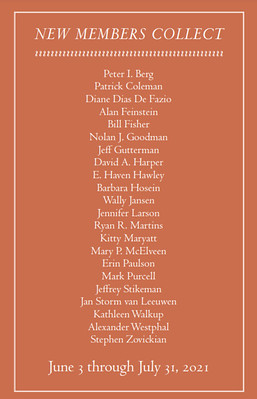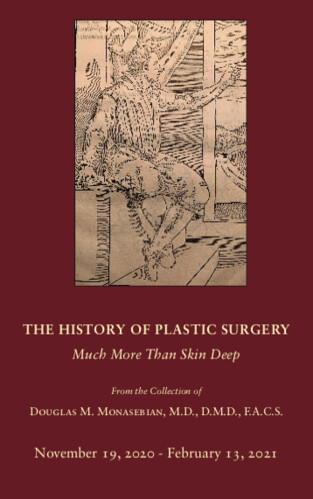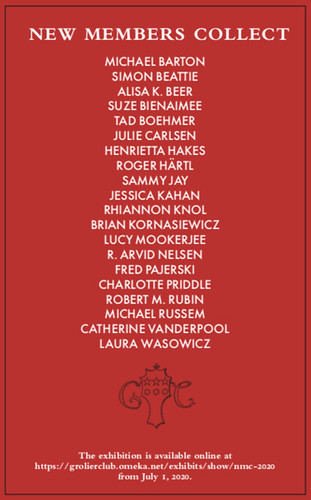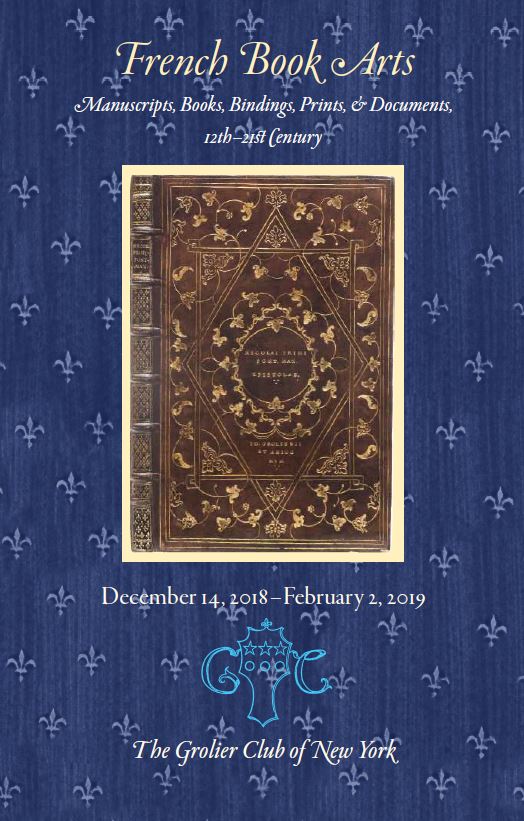Browse Exhibits (33 total)
New Members Collect 2021

Founded in 1884, the Grolier Club is America’s oldest and largest society for bibliophiles and enthusiasts in the graphic arts.
Named for Jean Grolier (1489 or 90-1565), the Renaissance collector renowned for sharing his library with friends, the Club’s objective is to promote “the study, collecting, and appreciation of books and works on paper.” Our members are an international network of over eight hundred book and print collectors, antiquarian bookdealers, librarians, designers, fine printers, binders, and other bibliophiles.
Anyone is welcome visit the Grolier Club's exhibitions, purchase its publications, attend its lectures and other public events, and apply to use its Library. Formal membership, however, is subject to certain rules and restrictions. The Grolier Club is a private bibliophile society, which means that candidates may not apply for membership, but must be nominated. Nominations are based on a candidate's personal and/or professional commitment to books, as demonstrated through outstanding activity as a collector, antiquarian book dealer, rare book librarian, or some other bookish pursuit.
Every year, the Grolier Club hosts a summer New Members Collect exhibition in our second floor gallery. This exhibition is an opportunity for anyone who was elected to membership in the previous year to showcase their personal collections, if they happen to collect.
Taming the Tongue in the Heyday of English Grammar (1711-1851): From the Collection of Bryan A. Garner

Collector's Statement
In September 1974, when I was a sophomore in high school, a teacher asked me to name the parts of speech. It was in a small college town in the Texas Panhandle, during the first meeting of a class called “English Grammar.” I hesitated on a couple of the answers, but here’s what I said: “Noun, verb, adjective, adverb, pronoun, preposition, conjunction, article, and interjection.” My classmates were impressed, it seemed, that I could remember this information we’d gained three years before.
“No,” the teacher said. “That’s wrong. Anybody else?”
Despite various attempts in the next few minutes, nobody could figure out where I’d gone wrong.
“You named nine parts of speech, Bryan. There are only eight. Articles aren’t among them. Articles count as adjectives.” I didn’t receive so much as a “Good try, though.”
In seventh grade, we’d learned that there are nine. Now, in tenth grade, we were being taught that one of those nine was illusory—that there are only eight.
That piqued my curiosity, so I decided to look further into the question. I went to the college library and consulted all the English grammars I could find. The answer to this simple question—the parts of speech—had wildly varying answers from different grammarians, ranging from 2 to 33. Given my newfound familiarity with grammars, I started acquiring them wherever I could find them in bookshops and library sales.
I’d become a collector—and a writer.
At first I wrote about Shakespeare’s language, then legal language, then the English language generally. In my late 50s, I circled back to write about English grammar and its colorful history.
Meanwhile, from 1988 through 2019, I set foot in about 300 bookshops a year. My work took me to all the major (and many minor) cities across North America, week by week—and sometimes to other continents as well. Over time, certain shops became favorites, and I’d return every chance I got—especially to those in Chicago, Columbus (Ohio), Denver, Detroit, Long Beach, Milwaukee, Minneapolis, Morristown (N.J.), Phoenix, Rockville (Md.), Saint Paul, Salt Lake City, San Diego, St. Louis, Tampa, and Wichita. I knew the owners, and they at least recognized the man who was oddly drawn to their reference and law sections.
My main interests are law, English dictionaries, English grammars, and linguistics. Rarely would booksellers be proud of those sections in their shops, and they’d be even less proud after I left the sections much smaller.
My fellow Grolierites are unfailingly patient with me when I warm to discussing English grammars. For that I’m grateful.
As off-putting as our memories may be about learning grammar, the stories of the grammarians themselves—their personal struggles, their rivalries, their enmities, their failings, their successes—have a universal appeal. Their stories are our stories, as if in a parallel universe.
Whatever you take away from this exhibition, I hope you’ll find some lessons and truths about humanity. I’ve tried to recover as much of the human story as I could from the dustiest, most neglected sections of my beloved bookshops, many of which, alas, no longer exist.
—Bryan A. Garner
Magazines and the American Experience: Highlights from the Collection of Steven Lomazow, M.D.

Magazines and the American Experience:
Highlights from the Collection of Steven Lomazow, M.D.
The first successful magazine proudly proclaimed itself as The American Magazine in 1744. Magazines in the colonial era became the clarions of revolutionary thought, and the first printed statement of American independence appeared in Thomas Paine’s Pennsylvania Magazine in June 1776. At the outset of the nineteenth century, magazines documented the origins of the political schism between Federalism and states’ rights that remains a subject of bitter debate to this day.
As publishing expanded, magazines fostered the development of distinct communities of Americans by creating networks of communication, much as the internet does in today’s digital age. We learn from them the history and development of American farmers and tradesmen; women and children; poets, humorists, artisans, reformers and religious groups of every denomination and ethnicity. Magazines and the American Experience is a celebration of this vitally important American medium.
The exhibition is presented in two sections, beginning with a chronological history of American magazines from 1733 to the present. The second is devoted to a broad spectrum of genres which address the areas of popular culture that became a major focus of American magazines in the late nineteenth and twentieth centuries, including American artists and humorists, the ongoing struggle of African Americans to achieve equality, a salute to our national game of baseball, and the development of radio, television, and motion pictures.
The accompanying catalogue expands upon the exhibition with a series of essays by leading historians of publishing, enhanced by over four hundred illustrations.
Curated by Steven Lomazow, M.D. and Julie Carlsen
The History of Plastic Surgery: Much More Than Skin Deep

"The History of Plastic Surgery: Much More Than Skin Deep" from the Collection of Douglas M. Monasebian, M.D., D.M.D., F.A.C.S.
I am not sure if every historian is a bibliophile, but I am quite sure that every bibliophile is a historian. To collect books not only requires one to understand the world as it was when the book was written but to appreciate the thoughts and ideas of the author as he went about his writings. As my personal collection grew, this became my driving force. I sought out books in plastic surgery that not only had significance in the progression of plastic surgery as a medical discipline but also possessed historical importance. Studies on facial expression, disease, and obesity were just as interesting to me as the first surgical descriptions of nasal reconstruction or cleft palate repair were.
While I have not always collected the aforementioned books, being a passionate collector has been a significant part of my life from a young age. At eight years old, I began collecting baseball cards; my collecting interest then shifted to Mad magazine through adolescence. I also recognized as a child that I wanted to become a surgeon. I was fascinated by science, loved working with my hands, but most importantly desired to be in a profession where I could help people. After graduating from dental school, I had a thirst for more knowledge in a different field of work and continued my education by going to medical school. I completed residencies in both oral and maxillofacial surgery and plastic surgery and then ventured into private practice.
As I grew comfortable in my private practice and had more discretionary time, I studied more on the history of my profession and learned that the fathers of modern-day plastic surgery were trained in the same fashion as myself. Their entry into this type of work was for different reasons; however, that made little difference to me. These individuals had medical and dental backgrounds and focused primarily on facial reconstructions that became increasingly prevalent because of the injuries soldiers suffered during World War I. This unique history enriched my experience and inspired me in my profession, which culminated in a desire to learn even more about the specialty. As with most surgeons, I can be obsessively compulsive and love to face different challenges. My new goal became to learn from everything I could get my hands on to uncover the multifaceted and fabulous history of plastic surgery. Unlike my past collecting endeavors, there is no simple checklist applicable here. One does not and cannot acquire sequential cards or magazine numbers and deem the collection to be complete. As any true collector knows, the deeper one gets into the collection, the further it spreads out. I saw myself seeking out not only books but photographs, autographed letters, instruments, and paper ephemera. All of it found a place in the collection and complemented the whole beautifully.
As medicine evolved throughout the last millennium, so did surgery. The barber surgeons of the 16th and 17th centuries were becoming more daring and sophisticated in their approaches to surgery. Although crude for the modern-day, some plastic surgery procedures have withstood the test of time and are still successfully employed today. For example, Tagliacozzi’s forehead flap can still be used, as can skin-grafting practices from the 1800s. The advent of antisepsis, anesthesia, and asepsis in the 19th century helped to make plastic surgery safer and more predictable. To the contrary, cleft lip repairs prior to the 18th century are now outdated.
I trust your exploration of this exhibit will allow you to share in the joy I have had while creating it. I also want to take this opportunity to thank my beloved parents, who continually inspired me to “do whatever I wanted to do in life, as long as it was to the best of my best ability.” And to my beautiful wife and children, thank you for your patience and support as my collection grew and diversified.
Douglas M. Monasebian, M.D., D.M.D., F.A.C.S.
Further Impressions: Major Grolier Club Library Acquisitions, 2005-2020

In 2004 the Grolier Club mounted a comprehensive survey of our unique Library on the art and history of the book and graphic arts. "Lasting Impressions" (May 12-July 31, 2004) traced the development of the Grolier Club Library over the course of more than a century, showcasing the important but seldom-seen books, manuscripts, prints, drawings and realia that have made the Library a world-class resource for scholarship in book collecting, bibliography, graphic design, typography, printing history, and the book trade.
In the fifteen years since the "Lasting Impressions" show, the Club has maintained an extraordinary rate of significant growth in its primary areas of focus. Thanks to the generosity of our members and foundation partners, since 2005 the Club can boast acquisitions rivaling the importance of those made in the course of its previous history.
Now more than one hundred and thirty five years old, the Grolier Club Library has earned the right to define "major acquisitions" in its own way, recognizing that the small, drab, unassuming, inexpensive object may rival the splendid and expensive high-spot in importance. The one hundred items in this show reflect that philosophy of inclusion, juxtaposing poorly printed pamphlets with monuments of book-making, modest paper wrappers with elaborately tooled bindings, and cheap woodcuts with splendid hand-colored engravings—all, despite differences in appearance and quality, with important stories to tell about the art and history of the book.
In 2004 the Grolier Club Library had several milestones to celebrate, including the recent launch of its first-ever online catalogue. In 2020, in the face of global upheaval, the Grolier Club offers this "Further Impressions" exhibition as evidence of growth in a time of drought, of continuity in a period of disconnect, and of quiet scholarship in the midst of clamorous debate.
Meghan Constantinou & Eric Holzenberg, Curators
Photographs by Nicole Neenan
A Century of Dining Out: The American Story in Menus, 1841-1941

Menus are minor, transient documents that tell us how people have dined outside the home over time. Examine one and be transported back to the everyday life of the past - whether to a lavish banquet in the Gilded Age or a food-relief eatery during the Great Depression. They aid our cultural memory by providing historical evidence, not only of what people were eating, but what else they were doing and with whom they were doing it; and what they valued.
In the United States, menus came into general use in the 1840s when hotels and restaurants began to replace the old inns and taverns that served a limited choice of domestic-style meals. Dining among strangers in quasi-public spaces became a new and novel kind of entertainment in which the menu played a central role, offering diners choice and anticipation for the first time. Menus suddenly appeared in all types of venues and forms of transportation.
Since menus reflect all aspects of society, it was possible to weave a literary thread through the exhibition, including rare examples from a haunt of Edgar Allan Poe, Mark Twain's seventieth birthday party at Delmonico's, and a long-forgotten reception for French zoologist Paul B. Du Chaillu in the New Mexico Territory. The annual dinners of the American Booksellers Association and the Bibliophilic Society recall the social world of book dealers and prominent collectors in New York at the turn of the last century.
The menu is an art form that aims to please. While most were intended for short-term use and not meant to be saved, others were finely crafted by high-society stationers such as Tiffany's and Dempsey & Carroll. Even when kept as personal mementos, however, they were frequently discarded by later generations for whom they had no special meaning. As with other types of ephemera, part of their appeal lies within the notion of their improbable survival.
Curated by Henry Voigt
Stanley D. Scott Gift

Highlights from the Stanley D. Scott Gift
The Grolier Club Library has launched an online exhibition celebrating the recent gift of approximately 100 rare books and prints donated to the Club by longstanding member, Stanley D. Scott. With this gift, the Grolier Club joins such prestigious institutions as the American Numismatic Society and Mount Vernon as the recipients of Mr. Scott’s generous benefaction. A corresponding physical exhibition will be mounted in the second floor gallery in October 2020.
The collection, formed by Mr. Scott over three decades, represents the collector's wide and evolving range of interests. This eclecticism is revealed in the great variety of subjects presented in the exhibition. From classic travel literature like the first edition of Captain Bligh's account of the Mutiny on the Bounty; to a rare state of Charles Dickens's A Christmas Carol; to esteemed botanical books like Robert John Thornton’s Temple of Flora (London, 1812), many visitors will find items that appeal to their tastes.
A particular highlight is a copy of the Nuremberg Chronicle with a royal provenance, elegant penwork initials, and some original hand-coloring. Thanks to Mr. Scott’s generosity, the Grolier Club now has a splendid copy of this iconic work, which will be used for teaching, exhibition, and enjoyment by visitors to the Library. In addition, the Grolier Club will add six other works from the Scott gift to its permanent collection, including a fine impression of Albrecht Dürer’s Joachim and the Angel (1511 Latin edition), a stunning binding designed by Alice C. Morse for Washington Irving's The Alhambra, and the first book from the Golden Cockerel Press ‘Sea Log’ series.
We invite you to explore this rich and multi-faceted collection, presented in honor of Mr. Scott and his generous support of the Grolier Club Library.
Curated by Meghan R. Constantinou, Grolier Club LibrarianPhotographs Courtesy of Thomas Lecky, Appraiser
New Members Collect 2020

Founded in 1884, the Grolier Club is America’s oldest and largest society for bibliophiles and enthusiasts in the graphic arts. Named for Jean Grolier (1489 or 90-1565), the Renaissance collector renowned for sharing his library with friends, the Club’s objective is to promote “the study, collecting, and appreciation of books and works on paper.” Our members are an international network of over eight hundred book and print collectors, antiquarian bookdealers, librarians, designers, fine printers, binders, and other bibliophiles.
Every year, the Grolier Club hosts a summer New Members Collect exhibition in our second floor gallery. This exhibition is an opportunity for anyone who was elected to membership in the previous year to showcase their personal collections, if they happen to collect.
Although in 2020 our galleries have been closed for the summer due to the COVID-19 health emergency, our new members still have the opportunity to share their collections. We've assembled an online version of New Members Collect, which illustrates the wide range of materials in the world of books and the graphic arts that have captured the interests of our members.
The Best-Read Army in the World

Books and war have long been intertwined. But no war exhibited this relationship like World War II. As Germany and Japan banned titles and authors and burned over 100 million books, American librarians and publishers retaliated by distributing over 140 million books to American troops.
Beginning with the 1942-1943 Victory Book Campaign (“VBC”), librarians collected 18 million books for the armed services. These hardcover donations were devoured in stationary libraries at training facilities, but overseas troops reluctantly left these heavy books behind.
In 1943, American publishers took up the torch and redesigned the book to meet the needs of ground troops. Breaking with tradition, publishers embraced paper covers, pocket-sized dimensions, and dual columns of text. Over the next four years, 123 million “Armed Services Editions” (ASEs) were printed, distributed, read, and cherished.
ASEs transformed American reading habits and the entire book industry. At war, men who had never read developed a passion for books. As the New York Post boasted, America had “the best-read army in the world.” In the words of one sailor, a man was “out of uniform if [an ASE] isn’t sticking out [of] the hip pocket!” When President Roosevelt announced the GI Bill, troops were eager to pursue a college degree—they had read ASEs in foxholes; surely they could read and learn in classrooms.
After the war, paperbacks became a ubiquitous staple of the industry. While publishers had previously eschewed paperbacks out of fear that they would diminish hardcover sales, they discovered that paperbacks appealed to an entirely new audience of book readers.
Curated by Molly Guptill Manning.
French Book Arts from the Collections of the Grolier Club

The founders who conjured The Grolier Club into existence 135 years ago were imbued with the spirit of French bibliophilia and devoted to the arts of the book in France. They named the Club after Jean Grolier (1489/90-1565), Treasurer of France, the greatest patron of the book arts in his era, an inspiration to book collectors then and now, deservedly known for the past half-millennium as "The Prince of Bibliophiles." They sought to raise the quality and style of printing in America by fostering well-designed and well-produced publications; they built their private libraries through Parisian agents; they had their rare books bound in France; they persuaded master bookbinders to emigrate from Paris to New York and establish the Club Bindery.
The members of that first generation were generous in their direct support of the Club's collections in the book arts, so you will find collection items on display here that were donated as early as the 1880s and '90s. This generosity has motivated Club members over our many decades, and continues to do so.
The program of the many hundreds of exhibitions that the Club has presented to the public from our earliest days has celebrated in selective depth the manifold arts and history of the book. A prime distinction of "French Book Arts" is that this is the first exhibition that presents a survey of so many areas of French bibliophilia, from Medieval and Renaissance illuminated manuscripts to the livres d'artistes that have been a hallmark of the book arts in France for well over a century.
This inaugural exhibition in our new gallery and its companion volume are presented in memory of Mary K. Young, staunch Francophile throughout the life she spent in service to others, and a devoted member of the Club. Mary loved the Club, and we loved her.
Curated by H. George Fletcher, December 14, 2018 - February 2, 2019.










